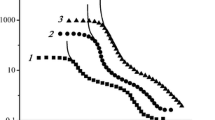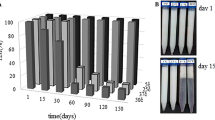Summary
The stability of oil-in-water emulsions depends ultimately on the physical nature of the oil-water interface. If a hydrocolloid or protein is used as an emulsifying agent an interfacial film is formed at the oil-water interface and this may be liquid or viscoelastic solid in properties. The film is formed by the two processes of diffusion from the bulk to the interface and the formation of secondary intermolecular cross-links.
Gelatine solutions of up to 2% w/v were used to form an interface with light liquid paraffin over a restricted range of p h . For the 2% w/v gelatin solutions, the p h range was confined to the acid region p h 2.5–3.2 owing to the onset of gelation of the whole aqueous phase, at room temperature, if the p h was increased numerically above this range. At lower concentrations of gelatin, e. g., 0.5% w/v, the useful p h range could be extended to p h 4.
The interfacial rheological properties were examined using the surface rheometer described in a previous paper. Preliminary results showed that, in the case of the 1% w/v gelatin solution at p h 3, the interfacial film was liquid up to the end of the first half-hour after formation. Solid properties then developed. After 4 hs it was possible to carry out a creep experiment on the film which exhibited a longest retardation time of several minutes. Further creep and recovery experiments conducted up to 200 h after the formation of the film clearly showed that the growth of solid properties of the film was continuing.
The gelatin interfacial films were considerably more compliant than similar films of acacia Senegal, over a comparative period of time, and at the same bulk concentration. This difference in behaviour can be attributed to differences in the basic molecular structure of the two polymers.
Zusammenfassung
Die Stabilität von Öl-in-Wasser-Emulsionen hängt letztlich von der physikalischen Eigenschaft der Öl/Wasser-Grenzfläche ab. Wenn ein Hydrokolloid oder ein Protein als Emulgator verwendet wird dann bildet sich in der Öl/Wasser-Grenzschicht ein Film, der Flüssigkeitsoder viskoelastische Eigenschaften aufweisen kann.
Dieser Film wird durch zwei Diffusionsvorgänge von der Gesamtmasse zur Grenzschicht und durch zwischenmolekulare Vernetzung gebildet.
Gelatinelösungen bis 2% (Gewicht/Volumen) wurden verwendet, um mit dünnflüssigem Paraffin über einen beschränkten p h -Bereich eine Grenzschicht zu bilden. Für die 2% Gelatinelösung wurde der p h -Wert im sauren Bereich zwischen p h 2,5–3,2 gehalten, weil bei Erhöhung des p h die gesamte wässerige Lösung bei Raumtemperatur zu gelieren begann. Bei geringeren Gelatinekonzentrationen, wie z. B. 0,5% (g/ml), konnte der brauchbare p h -Bereich bis zu P h 4 ausgedehnt werden.
Die rheologischen Eigenschaften der Grenzschicht wurden mit dem Oberflächenrheometer untersucht, das in einem vorhergehenden Vortrag beschrieben wurde.
Vorläufige Ergebnisse haben gezeigt, daß im Falle einer 1% Gelatinelösung mit p h 3 der Grenzfilm bis gegen Ende der ersten halben Stunde nach seiner Bildung flüssig war. Dann zeigte dieser Festkörper-Eigenschaften. Nach 4 Std. konnte der Film in einem Kriechtest untersucht werden; wobei maximale Retardationszeiten von mehreren Minuten beobachtet wurden. Weitere Kriech- und Kriecherholungsversuche, die bis zu 200 Std. nach der Filmbildung durchgeführt wurden, zeigten deutlich, daß die Festkörper-Eigenschaften des Filmes weiterhin zunahmen.
Gelatinegrenzflächenfilme waren für einen vergleichbaren Zeitraum und eine ähnliche Gesamtkonzentration beträchtlich nachgiebiger als ähnliche Filme mit Acacia Senegal. Dieses unterschiedliche Verhalten kann von den verschiedenen molekularen Grundstrukturen der beiden Polymeren herrühren.
Similar content being viewed by others
References
Sumner, C. G., in: Clayton, The Theory of Emulsions and their Technical Treatment. 5th Ed. (London 1954).
Briefer, M. andJ. H. Cohen, Ind. Eng. Chem.20, 408 (1928).
Ghanem, A.-H., W. I. Higuchi, andA. P. Simonelli, J. Pharm. Sci.58, 165 (1969).
Rich, A. andF. H. C. Crick, in: Recent Advances in Gelatin and Glue Research.Stainsby, G., Ed., p. 20 (Oxford 1958).
Rich, A. andF. H. C. Crick, J. Molec. Biol.3, 483 (1961).
Pearson, J. T. andA. E. Alexander, J. Colloid Interface. Sci.27, 53 (1968).
Joly, M., in: Recent Advances in Surface Science.Danielli, J. F., K. G. Pankhurst, andA. C. Riddiford, Eds. p. 1 (New York 1964).
Limberg, H., Rec. trav. chim.45, 772 (1926).
Ellis, S. C. andK. G. A. Pankhurst, Disc. Faraday Soc.16, 170 (1954).
Tschoegl, N. W. andA. E. Alexander, J. Colloid Sci.15, 168 (1960).
Tachibana, T., K. Inoguchi, andH. Kakiyama, in: Recent Advances in Gelatin and Glue Research.Stainsby, G., Ed., p. 243 (Oxford 1958).
Shotton, E. andK. Kalyan, J. Pharm. Pharmacol.12, 109 (1960).
Biswas, B. andD. A. Haydon, Proc. Roy. Soc. Ser. A.271, 296 (1963).
Janus, J. W. andR. L. R. Darlow, Nature194, 1075 (1964).
Barry, B. W. andB. Warburton, J. Soc. Cosmetic Chemists19, 725 (1968).
Warburton, B., J. Texture Studies1, 379 (1970).
Alexander, P. andR. J. Block, A Laboratory Manual of Analytical Methods of Protein Chemistry including Polypeptides. Vol. 2 (New York 1960).
Shotton, E., K. Wibberley, B. Warburton, S. S. Davis, andP. Finlay, Rheol. Acta10, 142 (1971).
Bulas, R. andC. A. Kumins, J. Colloid Sci.13, 429 (1958).
Warburton, B., S. C. I. Monograph 24. The Chemistry and Rheology of Water Soluble Gums and Colloids, 118 (1966).
Pouradier, J., J. Chim. Phys.46, 627 (1949).
El-Shimi, A. F. andV. N. Izmailova, Abh. Deut. Akad. Wiss. Berlin (Chem. Geol. Biol.)6, 868 (1966).
Nemethy, G., Angew. Chem. Int. Ed. Engl.6, 195 (1967).
Davies, J. T. andG. Mayers, Trans. Faraday Soc.56, 691 (1960).
Author information
Authors and Affiliations
Additional information
Paper presented to the British Society of Rheology Conference on Rheology in Medicine and Pharmacy, London, April 14–15, 1970.
Rights and permissions
About this article
Cite this article
Kislalioglu, S., Shotton, E., Davis, S.S. et al. Rheological properties of thin gelatin films. Rheol Acta 10, 158–164 (1971). https://doi.org/10.1007/BF01972494
Received:
Issue Date:
DOI: https://doi.org/10.1007/BF01972494




